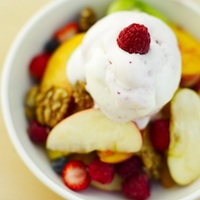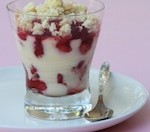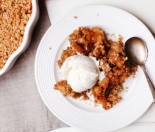Desserts are always the children’s favourite part of the meal – but family desserts do not need to be unhealthy. Read on for great ideas.
Dessert is a term used for something that follows the main course and is usually sweet in flavour. Therefore it could just be a serving of fruit where the natural sweetness of the fruit would meet this definition.
It is not that long ago that desserts may have been part of the family meal nearly every night of the week. Previously it may have ranged from a baked dessert to the simple fruit and ice cream. It was not uncommon to serve milk with any baked desserts – a much better choice nutrition choice compared to the runny or whipped cream which may also have been on offer.
Desserts may have been served on a regular basis for a couple of reasons – it was a tradition and back then the meal perhaps never seemed complete without the dessert. But it also had a practical role of extending the meal and making it more satisfying.
Today very few parents actually do this. Finding time to make dessert is just not a priority in our busy lifestyles and it is not something that we typically need nutritionally.
If you do offer desserts on a regular basis try to make sure that they are nutritious and satisfying.
Young teenagers may need a dessert type option to help satisfy their appetite after an evening meal. For the very active child a dessert may also be necessary to help meet their increased energy needs. Making wise choices which help meet other nutritional needs is important – making choices based on food groups such as fruit or dairy products is one way of adding good nutritious options into the daily eating pattern.
If you are concerned about your child’s weight then it may be appropriate to consider if it is appropriate to even offer another choice after the main meal. So that the child with the weight problem does not feel disadvantaged or punished this needs to be a united family rule – not just one that targets the child with the weight problem.
Dessert tips
Do not use a dessert as a bribe:
Do not encourage your children to eat their vegetables by bribing them with a dessert. Studies have shown that this does not work – your child ends up disliking the vegetable even more and being encouraged to develop a greater liking for the sweet option.
Fruit
Desserts are an ideal way to include a serving a fruit. It could just be raw fruit or a serving of canned fruit with a breakfast cereal. You could do fruit kebabs and include marshmallows. Fruit crumbles are good quick dessert, especially good in the winter time. You can boost the fibre in the crumble topping by adding rolled oats or crushing up weetbix.
Milk products
Milk products can be included in desserts and can be a good way of getting more calcium into the diet. Yogurt or dairy food is a simple dessert which takes no effort to prepare. Serving custard (or yogurt) with fruit is another good way to include both dairy and fruit after a meal. Ice-cream is also another dairy based choice – don’t offer it every night but occasionally it is acceptable.
Treats
Sometimes it is nice to have a choice which may be either high in sugar and / or fat – the key is to make sure it is not a regular part of the eating pattern. If possible try to discourage seconds. The key is to enjoy the treat with out encouraging any guilty feelings. If these treats are requested frequently then tell your children why it is not a good idea to include them regularly in the diet – call them treat foods and let them know that it is not healthy to eat them every day.
Useful articles
For information and ideas on great drinks for kids, visit Drinking Fluids.
Breakfast is such an important meal for children – read more about Breakfasts here, with great tips from a registered dietitian.






